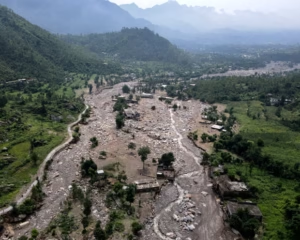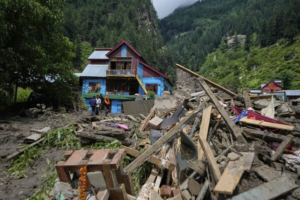How South Asia Can Prepare for Deadly Cloudbursts: A 2025 Wake-Up Call
Overview:
In the 2025 monsoon season, cloudbursts have claimed over 800 lives across Pakistan and India, particularly in mountainous regions. These high-intensity rainstorms often last only minutes but trigger devastating flash floods, landslides, and village-level destruction. Due to climate change, poor urban planning, and a lack of advanced warning systems, these disasters are growing deadlier with each passing year.
Outline
I. Introduction
II. Causes of Cloudbursts
III. Consequences
IV. Major Incidents (2025)
V. Challenges in Management
VI. Way Forward
VII. Conclusion
I. Introduction
A cloudburst is an extreme weather event characterized by 100 mm or more rainfall within an hour in a limited geographical area, often less than 25 km². In South Asia, particularly in the Himalayan and Hindu Kush regions, these events are catastrophic due to narrow valleys, fragile slopes, and high population density.
II. Causes of Cloudbursts
- Geographical Triggers
Steep terrains in northern Pakistan and Indian Himalayas trap moist air masses, pushing them upward. As the air cools, it rapidly condenses into dense cumulonimbus clouds that suddenly collapse and release torrential rain. - Monsoon Air Dynamics
Warm, humid air from the monsoon collides with colder alpine air in mountainous regions, creating violent convective storms. - Climate Change Impact
Global temperatures have increased by over 1.1°C, causing the atmosphere to hold 7% more water vapor. This amplifies storm intensity, especially during monsoon peaks. - Jet Stream Disturbances
Displacement of the subtropical jet stream increases vertical instability, leading to abrupt cloudburst formation. - Environmental Degradation
Deforestation, soil erosion, and unregulated construction reduce the natural absorption capacity of mountain slopes—magnifying the impact of sudden rainfalls.

III. Consequences of Cloudbursts
- Loss of Life: Flash floods kill residents instantly, often while sleeping or working.
- Infrastructure Collapse: Bridges, homes, and roads are washed away in minutes.
- Agricultural Devastation: Crops, livestock, and food storage facilities are destroyed.
- Economic Damage: Regional economies suffer billions in losses due to damage and displacement.
- Psychosocial Trauma: Survivors face long-term mental health challenges from displacement and bereavement.
IV. Major Cloudburst Incidents – 2025
| Region | Event | Impact |
|---|---|---|
| Buner, Pakistan | Cloudburst + flash floods | 200+ deaths, entire neighborhoods submerged |
| Kishtwar, India | Pilgrimage-site disaster | 67 dead, 300+ injured, 200 missing |
| Swabi, Pakistan | Cloudburst in lowland | 15 killed, mud homes destroyed overnight |
| Karachi, Pakistan | Urban flooding | 10+ deaths, 160 mm rain in one day |
| Kashmir Region (India) | Landslide after rainfall | 60 killed, army rescue operation launched |
| Cumulative Toll (2025) | – | Pakistan: 700+ deathsIndia: 130+ deaths |
V. Challenges in Coping with Cloudbursts
- Lack of Early Warning Systems
Doppler radar and AI-based forecasting systems are absent or insufficient in remote areas. - Weak Infrastructure
Rural homes, often made of mud and stone, are highly vulnerable to flooding and landslides. - Unregulated Construction
Illegal settlements on riverbanks and hillsides are at constant risk. - Poor Disaster Preparedness
Many communities lack emergency drills, evacuation plans, or communication systems. - Limited Regional Coordination
Cross-border rivers and shared weather systems need joint monitoring, which remains inadequate.

VI. Way Forward
- Advanced Forecasting Technologies
Investment in Doppler radar, weather balloons, and satellite surveillance in mountainous regions. - Disaster-Resilient Infrastructure
Use of flood-resistant materials and elevated structures in high-risk zones. - Public Awareness Campaigns
Conduct regular evacuation drills, community alert systems, and school-based disaster education. - Reforestation and Land Management
Planting trees and terracing slopes to prevent soil erosion and landslides. - Regional Collaboration
India, Pakistan, Nepal, and Bhutan must share meteorological data and flood alerts.
VII. Conclusion
Cloudbursts are no longer rare anomalies—they are a new norm in a warming world. South Asia’s vulnerability is compounded by geography, infrastructure weakness, and poor governance. Mitigating future disasters requires proactive planning, technological upgrades, and regional cooperation to reduce loss of life and property.
VIII. Vocabulary Table
| Word | Meaning | Synonyms | Antonyms | Urdu Meaning |
|---|---|---|---|---|
| Cloudburst | Sudden heavy rainfall | Downpour, deluge | Drizzle, drought | موسلا دھار بارش |
| Flash Flood | Sudden flood after rain | Torrential flow, surge | Gradual rise | اچانک سیلاب |
| Catastrophic | Disastrous, causing devastation | Tragic, ruinous | Minor, harmless | تباہ کن |
| Vulnerable | At risk, easily harmed | Exposed, weak | Safe, protected | کمزور / خطرے میں |
| Condensation | Gas turning to liquid | Precipitation, moisture | Evaporation | بخارات کا پانی بننا |
| Evacuation | Moving people to safety | Withdrawal, relocation | Settlement, arrival | انخلا |
| Resilience | Ability to recover quickly | Toughness, flexibility | Fragility, weakness | لچک، بحالی کی صلاحیت |
| Mitigation | Reduction of severity | Alleviation, relief | Aggravation, intensification | کمی / تدارک |
| Infrastructure | Physical framework of systems | Foundation, facilities | Ruin, disrepair | بنیادی ڈھانچہ |
| Landslide | Sudden collapse of earth | Earthfall, slope failure | Stability, plateau | زمین کھسکنے کا عمل |
IX. Facts & Figures – 2025 Monsoon Season
- 100 mm/hour of rainfall qualifies as a cloudburst.
- 200+ deaths in Buner, Pakistan within 60 minutes of cloudburst.
- 344+ total deaths in Pakistan from cloudburst-triggered floods.
- 67 killed and 200+ missing in Kishtwar, India.
- 163.5 mm rainfall in Karachi, overwhelming 40 mm capacity drainage.
- 800+ fatalities reported across both countries due to cloudbursts.
- A 1.1°C rise in global temperature leads to 7% more atmospheric moisture.
- More than 5,000 homes have been damaged or destroyed this season.
- Rescue operations involved army helicopters, boats, and sniffer dogs in several districts.

